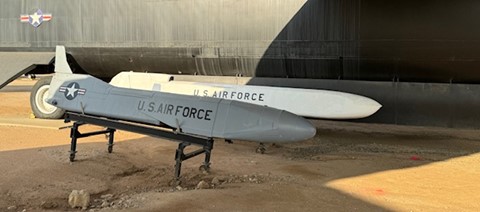
Key to the United States nuclear deterrence in the post-World War Two era the Triad concept depended on three strong legs. Land-based Inter-Continental Ballistic Missiles, sea-based Submarine Launched Ballistic Missiles, and land-based bombers. By the late 1970’s the increasing non-survivability of conventional aircraft significantly weakened the effectiveness of the bomber force. The search for practical solutions to strengthen the Triad’s third leg brought an imaginative solution.
Boeing’s AGM-86 Air-Launched Cruise Missile is a diminutive sub-sonic terrain following jet powered missile capable of carrying nuclear and conventional warheads. With a payload of twenty cruise missiles an ageing B-52 Superfortress could stand well clear of an enemy’s defenses and deliver a devastating precision attack deep inside hostile territory without fear of interdiction. At 20 feet long with a wingspan of twelve feet an AGM-86 following the terrain at low altitude is nearly impossible to detect.
Entering service in 1982, the AGM-86 changed the direction of warfare, bringing in the era of stand-off weaponry. From Desert Storm in 1991 to the battlefields of today the AGM-86 is a valuable weapon and fearsome deterrent.
The museum possesses two USAF AGM-86 mock-ups used for loading and transport training.
SPECIFICATIONS:
Weight: 3,150 pounds
Length: 20 ft. 9 in.
Join us in preserving aviation heritage. Your donation supports the meticulous restoration of historic aircraft, ensuring future generations can experience these flying legends up close. Every contribution brings us one step closer to getting them back in the sky.